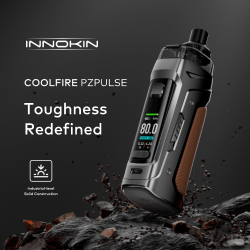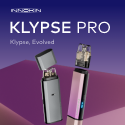Category: Rebuildables
THE HELIOS RDA, MY CHANGING THOUGHTS ON SUB-OHMING, AND SOME IDEAS ON SUB-OHMING SAFETY
A PBusardo Review – The Helios RDA and thoughts on sub-ohming safety
In this video we talk about the Helios RDA, my changing opinion of the sub-ohming world, and some ideas on sub-ohming safety.
The Links:
Vapehead Origins – US Site
Vapehead Origins
Parallel Resistance Calculator
Ohm’s Law Calculator
The Post Review Follow-up:
- 11/13/13 – Note that folks in the US need to use the https://vapeheadusa.com/ site and the price is $120 there. OKC Vapes also has it for $110. Sorry for the confusion.
The Video:
The Photos:
The Dan Newman Articles:
The Art of the Build: The what and why of cloud chasers
By Dan Newman
Hello, I’m Dan, and I’m a sub-ohm vaper. There are many misconceptions about me and my kind, and I’m here to clear some things up and hopefully give people a better idea of who we are and why we do the things we do.
What is a sub-ohm vaper? Technically, it’s a person who builds RBAs with coils at resistances lower than 1 ohm, but I’ll be focusing on people who go far below that. The cloud chasers, as some call us. You may have seen the videos of people blowing out massive, room-filling clouds and wondered how and why they do such things. Maybe you’ve read on forums that it is dangerous and we are all risking our lives by putting that big of a strain on our batteries. Are we using camera or lighting tricks? Some even think we are locked in a fatal pissing match to see who can get the biggest clouds.
Well, none of that is a true representation of this facet of the vaping world as it is today. The sub-ohm community is, for the most part, just that – a community. It’s a bunch of people posting on Facebook groups and on forums, or getting together IRL, showing off builds, asking questions and blowing clouds. It’s vapers helping vapers, and I call many of these people friends. We don’t get mad when someone posts a video with bigger clouds or any of that. The most common questions I get on my videos are for specifics of the build I’m using. People ask those questions to learn how others are doing things, improve their own builds and find new techniques to explore. There’s more comradely than competition in the community. But, as with any community, there are people who do it for the wrong reasons or just to be cool.
In preparation for this piece, I posted a question on various Facebook groups asking low ohm vapers why they vape sub-ohm, and what they get out of it. I added those replies to personal experience and the general feeling I get from the scene. First off, we are not locked in a contest to build the craziest, most dangerous setups to produce the biggest clouds. To be fair, this whole thing may have started with that mentality, but it’s not that way anymore. Most are trying to find the setup that gives them the best experience. Some want fluffy plumes with top notch flavor, others just want the biggest clouds they can get to showcase the hardware used or their skill at building. But none of us want to put ourselves in danger to get it.
So we read batteries specs, and concern ourselves with what devices have what voltage drop to safely get the most power to our coils. We read about the actual limitations of equipment we use and we either know the equations or have charts to tell us how many amps we’re pushing. With a mechanical mod, the voltage is raw battery power and wattage isn’t a useful value anymore. We watch videos to learn how to build coils, read about different kinds of wicking materials, new ways to wrap coils and this is all in the quest to find what works best for us.
The most important thing to sub-ohm vapers is the title of this piece: The Art of the build. The quest is for the ultimate build tailored to the builder’s specific want or need. Talking to each other and freely offering information improves everyone’s experience more than fighting and bickering ever could. The first thing you’ll be told when you get into the scene is to take it slow and build high-ohm coils first. Then, after you get the hang of building, start going lower if you want to. A rebuildable dripping atomizer can give a great vape with high or low ohm coils, and the beauty of the device is you can take them out whenever you want and build something new for maybe thirty cents.
And despite what everyone says about the dangers of vaping this way, I have yet to hear of a sub-ohm coil causing a mod to explode. The reason for that is education, and knowing what your equipment can and can’t do. We know to make sure the coil isn’t touching the metal deck or the topcap, that no loose wires are causing accidental connections and shorting out. We also check our builds with an ohm meter to find out whether the build is stable before we fire it for the first time.
The counterpoint to this is all the exploding e-cigs I’ve heard of causing fires and melting down have been eGo style devices or homemade mods with stacked batteries. No one recommends stacking batteries in a mechanical mod, by the way, because it is truly unsafe. Also, don’t leave your e-cigarettes unattended while charging in your car.
The last thing that needs to be cleared up is why we hold the atty up our ear before we take a vape. I’ve heard it’s because mechanical mods are unreliable and commonly misfire. I’ve heard it’s to look cool, or to fill some sort of social standard. Not true. The real reason is to hear if the atty is dry. Trust me on this, a dry hit at below .5 ohms is something you need only to endure once before you get into this habit.
My favorite build is around a .3 ohm dual coil setup on a dripping atty with 4 2mm airholes. It’s a lightning fast lung full of vapor yet not so hot it sacrifices flavor. I built for six or eight months before I tried one that low, and would recommend that everyone who wants to try it does the same. Buy a dripper, build a hundred coils, make your mistakes at 1.8 ohms on a regulated device or a mech with a fuse, then start building lower. And read, do your homework, join Facebook groups or forums, ask questions and make sure you understand the answers.
And if you want to do builds like I do, be prepared. By that, I mean I go through 15ml of juice and 5 18650s a day.
This whole vaping thing started to get us off smoking tobacco products, but vaping is totally different than smoking. Vaping offers more choices than what brand of death stick to buy, so explore and experiment and find what’s most enjoyable for you. Just be smart, educate yourself, and vape on.
Sub-ohm safety
By Dan Newman
Sub-ohm vaping can be done safely, and when it is, it’s a great vape which produces huge clouds off of quick pulls, rich flavor and a completely satisfying experience. In this piece, I’ll take you through precautions, what tools you need, warning signs something is going wrong, and how to learn to build a coil.
Let’s get the most important tool out of the way first. You need a multimeter. Read that last sentence again. Buy at least a decent quality multimeter, for no less than $20, and make sure it reads volts and ohms, since those are the only readings that matter for this application. Many regulated mods have a built in ohm checker, but it’s much harder to tell if something is wrong with your build with them. Another version of this tool is the little black box with 2 atomizer connections, an LED screen and an on / off switch on the top. We call these ohm checkers unicorns in the scene because they are hard to find, and they ultimately are less useful than a multimeter, but they can also help identify a questionable build. Also, since few regulated mods will fire builds lower than 1.2 ohms, you’re going to need to use mechanical mods, and the multimeter will allow you to check battery voltage to see when you need to charge them. More on these things later.
If you have a brick and mortar store or a friend who uses rebuildables, you’re lucky. I don’t have those available to me, so learned all I know about building from YouTube videos and talking to people online. I searched first for how to do simple builds and learned how to wrap wire around a piece of silica, which is the simplest build. I ordered an Igo-L, a bunch of wire and silica, and I built tons of coils. I would recommend starting out with 30 gauge kanthal A-1 wire for mechs, and 32 for regulated mods like the ProVari, Vamo or Zmax style devices. Just start out with a single strand of 3mm silica wick and, while watching a build video you like, wrap the wire around the wick four times. It’s a very simple build but well over 1 ohm. After you build the coil and attach it to your atomizer, use the multimeter to check the resistance. Set your multimeter to ohms, put the positive lead on center post and negative lead on the negative post and see what happens. Your reading may bounce around a little, but it if it’s erratic, that’s a sign something is going wrong. Make sure your coil isn’t touching the posts, the deck or any other metal in the atomizer. Trouble shoot your build, and YouTube has videos about how to do this as well. Learn to build stable and functioning coils without hotspots and take it all in baby steps.
After you can do a build you’re comfortable leaving the house with as your only PV for the day, then you are ready to start trying to build lower. Buy some 28 gauge wire to build with. 28 gauge is the gold standard starting point for sub-ohm building. Also, you’re not going to want to wrap a single strand of wick with this thick of wire. You’ll want 2 to 4 strands of wick to adequately provide juice to the coil. Take gradual steps down with low ohm builds. Try a 5/4 wrap, then try a 4/3 wrap, maybe even a 3/2 wrap. For example, a 4/3 wrap is 4 visible wraps of wire on the outside, 3 wraps on the inside, where the leads attach to the atomizer posts. After you are comfortable with that, then you can get into the really fun stuff, like the build I am rocking right now, a 6/5 twisted 27 gauge auto-dripper on an RSST with a cotton wick. It’s .55 ohms and maybe the best vape I’ve ever had. It’s fun to get crazy with techniques, but I’ve done so many builds to get to this point. I’ve built quads, duals, twisted, whatever, but I put in the time to get here. And I’ve had some scares too.
You need to start at higher ohms and make all your noobie mistakes there because a crossed lead at 1.8 ohms will generate heat as a warning sign of impending danger. The same mistake at .3 ohms could result in a trip to the hospital.
Most atomizers come standard with airholes sized for the masses. They are designed for flavor based on common usage, which is in the 1.5 to 2 ohm range. These air holes, usually 1.2mm, work well enough, but are unusable for super low ohm vaping. Bored out airholes have two purposes. The first is the most obvious: Airflow. To put out huge clouds you need to take in huge air. The second purpose is to cool down the build. A 0.4 ohm build can generate a surprising amount of heat, which translates to the top cap of the atty, the drip tip and the top of the mod. I can’t give an across-the-boards recommendation of what size airholes are best because it boils down to personal taste. Some atomizers have adjustable airflow, but they come with a hefty price tag. For beginners, find what you like by slowly boring them out. If your atty has 1.2mm airholes, widen them to 1.5 or 2mm and see if you like it. I have attys with one 3mm airhole, four 2mm airholes, and one with two 2mm X 5mm slots cut into it. All work great for me, but I tailor my builds specifically for each one.
Now, what to look for when a build is going bad. If your button gets hot, or if the body of the mod toward the bottom gets hot, stop using the mod. Also, if you hear hissing from the battery vents, that is very bad. Seriously, common sense is you best friend here. Wasted current translates to heat, so if your mod gets hot anywhere one inch south of the atomizer connection, something’s wrong. If the button gets uncomfortably warm or hot, something’s wrong. Also, e-cigarettes don’t naturally create sparks. Juice will pop off the coils, and it’ll sizzle, and strong builds actually seem like they are angry, but these are all normal. Atomizers will get hot, but not enough to heat up the entire mod during normal usage.
If your mod gets warm, take out the battery and if it feels hot, put it in a safe place such as a metal bucket and leave it alone for 10 minutes. If it hasn’t cooled down yet, put the bucket outside and see what happens. If it has cooled down, check over your build and look for scorching, melted insulators, anything that looks off in some way. Troubleshoot your build or rebuild it.
Also, micro-oxidation on certain metals such as aluminum can cause arching and voltage loss that turns to heat. Keep your mods clean. Every week or two of usage, with mechanicals specifically, will warrant a complete cleaning. I don’t mean take out the Brasso and shine up the exterior, I mean soak the parts in alcohol and scrub the threads with a toothbrush, use Q-Tips on other connections such as the 510, and remove any oxidation from the battery contacts. A mech is like any other machine, it works best with regular maintenance and neglect will cause it to fail. Also, Noalox is highly recommended for the threads because it is an anti-oxidizing conductive lubricant.
If the mod is a machine, the battery is the engine. You can have the best looking car in history, but if the engine isn’t on point what you have is no better than a Geo Metro. I have many kinds of batteries, but only use a few for sub-ohming. I trust the Sony 30 amp batteries, MNKEs and red AWs. That’s it for me. I’m not saying these are the only ones that work, these are just the ones I use. Do your research, use an online ohm’s law calculator or an app for your phone or tablet, or go old school and learn the formulas. Know how many amps you are requiring your battery to push. If you have an EFest 18650 which is rated at 10 amps and try and push a .3 ohm build with it, your atomizer is showing that battery a 14 amp load. You’re going to run into problems because you are severely over-taxing the battery. I have run the Sony 30 amp batteries at .15 ohms, a 28 amp load at 4.2 volts, and had no issues. But, I am very experienced at building sub ohms, have a high quality mod and I know what I’m doing. That build was for showcasing clouds and to see if I could do it. I normally don’t go below .3 ohms for various reasons, such as battery life.
And use 18650s. Even AW 18350s can’t safely fire anything under .6 ohms. AW 18490s can put out 16 amps, so those can fire .3 ohm coils, but 18650s will last longer. Protected batteries with higher mAh ratings, like the AW 2600 mAh 18650s are also no good for sub ohming. They sacrifice output power for higher mAh ratings, and can’t handle low ohm builds very well at all. They feel underpowered and get hot. The MNKE 18650 is 1500 mAh and a brute for sub-ohms, the Sony 30 amps are 1600 mAh, and red AW 1600 mAh 18650s are the powerhouses you’re looking for, and all are readily available for around $10-$15 each.
So, in conclusion, if you think something’s wrong with your build, something most likely is wrong. Check the battery first to see if it is hot, then check out your build, and if all else fails, completely disassemble and clean your mod. And if your button is still getting hot after a tear down and cleaning, your mod is unsafe. Period. Buttons get hot because current is going somewhere it shouldn’t, and increases the load on the battery. Oftentimes the spring in the button is causing a short, so you could try replacing the spring, but I prefer to just toss the mod at that point. I’ve had 2 mods do that, and both were shoddily made junky mods. You don’t have to spend a bundle on a mod, just get one that’s made well.
My last piece of advice is drop your nicotine levels to avoid crushing headaches. A rebuildable atomizer is the most effective nicotine delivery system, so drop your nicotine level by at least half. I started at 18, dropped to 12, and now I’m on 6. I’m about to drop to 3 because my builds are so strong I’m starting to get headaches off that.
I hope this article will act as a good stepping off point for your sub-ohm vaping adventure by providing you with tips and tricks I’ve learned along the way. Do your homework, talk to people and ask questions. Vape strong, people, just be safe about it.
THE KAYFUN LITE AND THE RUSSIAN 91%
A PBusardo Review- Kayfun Lite & The Russian 91%
In this video we take a look at the Kayfun Lite and the Russian 91%. Simply outstanding atomizers. We also do a micro-coil/cotton build in the Russian. I already put one in the Kayfun! 🙂
The Links:
(Russia)Kayfun Lite – Svoemesto
(US)Kayfun Lite – VaperRev
Russian 91% – EZig-Online
The Post Review Follow-Up:
10/28/13 – The price quoted in the review was the price in Russia when ordering directly from the SvoeMesto website. In the US, we need to order from the distributor which is VapeRev. There the price is $110.00.
12/16/13 – I noticed after the review that both the Kayfun Lite and the Russian 91% leak slightly through the fill hole screws on the bottom. It’s not a lot, but liquid does manage to find it’s way out. This has been resolved on the Kayfun Lite+ with the inclusion of a deeper set screw and an o-ring.
The Video:
The Photos:
SOME MORE PROVARI BLING FROM KIR FANIS AND THE ADAM A.M.R. – ADVANCED MESH REBUILDABLE
A PBusardo Review – Some more ProVari Bling & The ADAM A. M. R.
In this video we take a look at some new ProVari Bling from Kir Fanis and the ADAM A.M.R. – Advanced Mesh Rebuildable.
The Links:
GR-Modders
RampageVapor
The Video:
The Photos:
THE SMOKTECH RDA & AND MY FIRST GO AT MICRO COILS
A PBusardo Review – Smoktech RDA & Micro Coils!
In this video we talk about the Smoktech RDA and I have my first go at “Micro Coils” using an organic cotton ball wick.
Post Review Follow-up::
- 9/14/13 – Based on the YouTube comments, the biggest blunder in this video was an omission of the following step. The coils need to be held together with tweezers or a needle nose then fired or torched so they maintain the tight coil. Thanks to everyone who posted that and all the other tips!
- 9/14/13 – This was called the “Mini” RDA in the video. I now believe it’s the just the RDA, not the mini. The correct price on the MyVaporStore website is $9.25.
The Links:
My Vapor Store
Zulfiqar’s YouTube Channel
RiP Tripper’s YouTube Channel
The Video:
The Photos:
THE ITHAKA
A PBusardo Review – The Ithaka
In this video I answer a few questions I got about the Innokin iTaste MVP review and we take a look at the Ithaka RTA (Rebuildable Tank Atomizer).
Materials used for this build:
34 gauge Kanthal resistance wire (eBay) – 1.3 inches for this build
32 gauge Nickel no-resistance wire (eBay)
Organic Cotton Hemp Wick
Post Review Follow-up::
- 9/13/13 – I got the positive/negative totally ass backwards in this review. I made annotations to the video. It’s just a wording issue. The build you see if correct. Oh well, I’m only near perfect. 🙂
- 9/13/13 – The cotton wick you see in the build is performing REALLY well. Really nice vape. If only this were a little easier to build.
The Links:
Clouds Of Vapor
Cotton Wick From Mod & World
The Video:
The Photos:
SHOW AND TELL WITH THE TRICK TIP AND THE DIVER REBUILDABLE CARTO TANK ATTY REVIEW
A PBusardo Review -The Diver & a look at the Trick Tip
In this video we do a show and tell with the Trick Tip and then take a full look at the Diver rebuildable carto tank atty.
The Links:
Vape4Me
Atmistique
The Video:
The Photos:
THE RUSSIAN REVIEW
A PBusardo Review – The Russian
In this video we take a look at the Kayfun clone, The Russian.
The Links:
VapeCan
EZig Online
Post Review Follow-Up:
- 8/8/13 – Day two of the new build (as seen in the video) and this thing is flawless. Virtually all of the “harshness” (which was subtle to begin with) is gone. I’m also going through liquid faster 🙂 I’m thinking it was a combination of too low an ohm for that particular silica build and not getting the loops of the wick down deep enough into the atty chamber.
- 8/8/13 – US purchases of the original Kayfun should be made at VaperRev.
- 8/21/13 – With great wicking comes great juice usage! 🙂 Just to let you know, now that I’ve got this wicking the right away and a better build than my original, I’m down to around 4 hours on a fill. That’s more like it!!
The Video:
The Photos:
THE KILLER 705 & TSAF WIRE JOINER
A PBusardo Review – Killer 705 & TSAF
In this video we take a look at the Killer 705, resistance/no resistance joins, and the TSAF wire joiner.
The Links:
405 Vaperz
For information on the TSAF wire joiner contact: thetsaf@yahoo.gr
The Video:
The Photos:
THE AGA-S, THE SMOKTECH NICKEL MESH TANK CARTO, AND OUR VISIT TO LJ’S E-SMOKES
A PBusardo Review – The AGA-S, The Mesh Tank Carto, & The LJs E-Smoke B&M Visit
In this video we take a look at the AGA-S, the Smoktech Mesh Tank Carto, and my visit to Florida and LJ’s E-Smokes new brick and mortar location.
The Links:
KidneyPuncher
GotVapes
LJESmokes
The Video:
The Photos:
ANOTHER LOOK AT THE BT804 DREAM TANK
A PBusardo Video A Bit of a Rant & BT804 Dream Take 2
In this video I do a little rant about instructions and take another look at the BT804 Dream Tank. To all those who commented on YouTube in an attempt at helping me out on this one… Thank You!
The Links:
Vapor Bank
The Video:
The Photos:














 Store
Store












